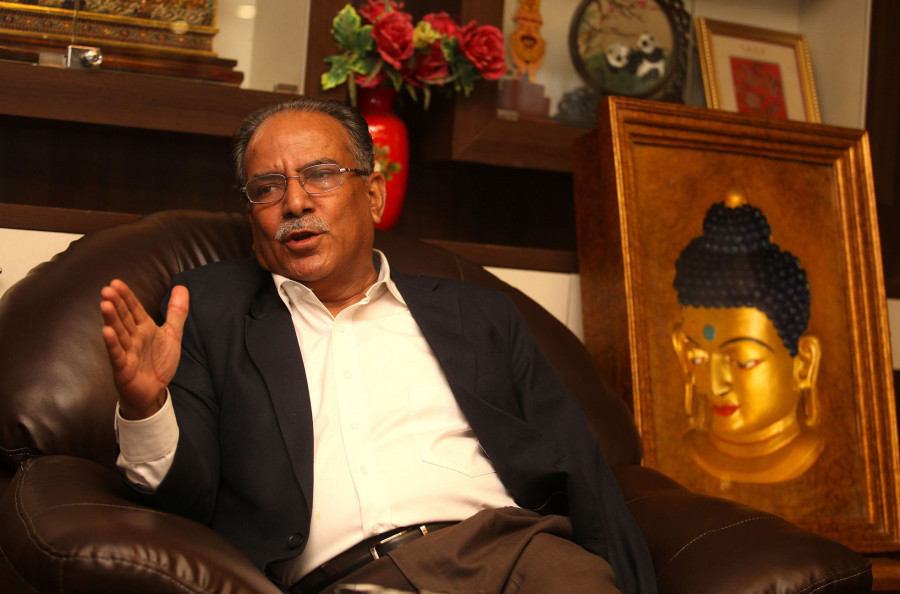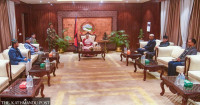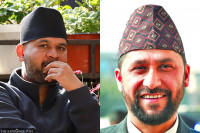Politics
Is Pushpa Kamal Dahal, Nepal’s former guerilla chief, headed for shedding the Maoist tag for good?
The Maoist Centre was dissolved after its merger with CPN-UML in May 2018, but it was thrust upon Dahal by the Supreme Court in March this year. The Maoist party now appears to have become an albatross around his neck.
Tika R Pradhan & Binod Ghimire
Last year, at Kantipur Conclave, Pushpa Kamal Dahal, tongue-in-cheek, talked about how he over the years had “dissolved” the parties that he led.
Responding to a question by Kantipur Editor-in-Chief Sudheer Sharma as to at what point of time he realised that he had had enough of Maoism, Dahal briefly went back to history.
“When I became the general secretary of the party, the first thing I did was I dissolved the [Communist Party of Nepal] Mashal party. I became the first leader to dissolve my own party,” he said. “When we prepared for the people’s war, [there was this party called Unity Centre], I dissolved the Unity Centre and formed the [Communist Party of Nepal] (Maoist). One can understand this in this series... that I dissolved the Maoist [party]... and also the CPN-UML, I would rather say.”
It had been a little less than a year since the Nepal Communist Party (NCP) was born. UML’s KP Sharma Oli and Dahal in May 2018 had announced merger to form the Nepal Communist Party.
“Now is it the turn of the Nepal Communist Party (NCP)?” asked Sharma.
“Yes, now it’s the turn of the Nepal Communist Party (NCP),” Dahal responded.
As though he had already foreseen, the Nepal Communist Party (NCP) did get dissolved, on March 7 this year, around 13 months after Dahal made the statement.
This time, however, courtesy the Supreme Court which ordered revival of the UML and the Maoist Centre. That said, the Supreme Court decision was rather the effect–and not the cause. The verdict came after a series of events that unfolded in the Nepal Communist Party (NCP) where Dahal was engaged in an intense power struggle with Oli.
Dahal’s last bid to get the Nepal Communist Party (NCP) revived was rejected by the Supreme Court on April 1. Oli is now leading the UML and Dahal the Maoist Centre.
Insiders say talks have been going on for a while about changing the name of Dahal’s current party–the Communist Party of Nepal (Maoist Centre).
With Oli bent on driving the Madhav Kumar Nepal group into a corner and in no mood to relent, a possibility of Dahal and Nepal joining forces has emerged.
“It is just a matter of time. The Madhav Nepal faction will join us sooner rather than later,” Pampha Bhusal, a Standing Committee member of the Maoist Centre, told the Post.
Bhusal confirmed, but rather obliquely, that a change in the name of the party is very likely.
“No leader from other parties will join a party that has the Maoist tag.”
Bhusal said that her party is in negotiations with different parties and leaders as well.
The Maoist Centre started considering changing the party name immediately after the court revived it and the UML, so as to shed the Maoist tag.
A meeting of the party’s Central Committee on March 13-14 even discussed the issue at length.
The way politics has unfolded in Nepal over the past few months and as a result, if Dahal indeed changes his party’s name, it would signify the formal end of the Maoists, or Maoism for that matter, in Nepal, many say.
“We don’t need to use ‘Maoist’ in our party’s name any more, as it’s significance has been over,” said Chakrapani Khanal, a Standing Committee member of the Maoist Centre.
The Communist Party of Nepal (Maoist) was born in 1994 under the leadership of Dahal. The party fought its “people’s war” under this name.
***
Stung by their failure of an urban resurrection in 1983, known as the “sector scandal”, the leaders – Dahal as well as the verteran communist leader Mohan Baidya – decided to implement the military strategy developed by the Chinese communist revolutionary leader Mao Zedong.
Dahal’s Communist Party of Nepal (Maoist) launched the “people’s war” in February 1996. Maoism formally entered Nepal. After 10 years, the war came to an end in 2006.
In January 2009, after the party’s merger with Ekatakendra Masal, a fringe communist force, it changed its name to Unified Communist Party of Nepal (Maoist). Dahal continued to remain the party chair. In 2012, a group of leaders including Dahal’s war-time lieutenants Ram Bahadur Thapa and Netra Bikram Chand, along with his mentor Baidya, decided to form their own party, saying Dahal had left the “people’s war” halfway and deviated from the core ideology.
Thapa, however, decided to return to the Dahal camp in 2016. The party was renamed Communist Party of Nepal (Maoist Centre). Chand, who parted ways with Thapa and Baidya in 2016 to launch his own “unified people’s revolution”, formed his own party named the Communist Party of Nepal, but he decided to shed the Maoist tag.
Besides Dahal, Baidya leads a party today that too has the Maoist tag–Communist Party of Nepal (Revolutionary Maoist). But it currently has an insignificant and inconsequential role in the national politics.
Baidya, however, disagrees that the significance of Maoism has ended in Nepal.
“If you look at the current political situation and the ground reality of the people, the significance of Maoism is actually even more,” Baidya told the Post in an interview. “If the significance has ended, it’s of those revisionist leaders who have fallen into the trap of the traditional parliamentary system.”
As talks are going on about Dahal planning to change his party’s name, many say there are chances of Baidya too coming under the “new roof” without the Maoist tag.
Baidya would not answer if he would shed the Maoist tag from his party. He, however, said “revolutionary forces” must come together once again. “And we will work towards that end. We will form a strong alliance of like-minded forces and people to achieve the goals of the people’s war,” said Baidya.
Badiya believes that nothing can be achieved without a struggle.
“We have our weaknesses and limitations, but we will adopt new ways as per the changed context, as things have changed drastically since Mao’s time,” Baidya told the Post.
Some analysts say now even Dahal and his party members don’t see any significance of carrying the Maoist tag, as they dropped Maoism long ago. The party actually had abandoned the tag in 2018 when it joined hands with Oli’s UML, but within the Nepal Communist Party (NCP), a struggle was continuing to justify the Maoist war.
That’s why the Maoist leaders jostled for adopting “21st century people’s democracy” as the party’s ideology, according to analysts, just as UML leaders made a pitch for continuing with their ideology of “people’s multiparty democracy”.
“It does not matter now whether the party sheds or keeps the Maoist tag,” said Bishwa Bhakta Dulal, usually known as Aahuti, who was once in Dahal’s Maoist party. “The ideological degradation in the Maoist party started with the dissolution of the first Constituent Assembly in 2012.”
According to Dulal, ever since the party was relegated to the third position in the second Constituent Assembly election in 2013, it started compromising and co-opting.
“They might have been calling themselves Maoists, but they stopped being Maoists long ago,” Dulal told the Post.
***
Dahal launched the Maoist war with an objective to bring about socio-political and economic transformation in the country, which could be summarised as abolition of the monarchy, a constitution drawn up by people’s representatives (Constituent Assembly) and changing Nepal into a federal republic.
The country achieved those formally on September 15, 2015 with the adoption of a new constitution.
But less than two weeks after the “historic” event, Baburam Bhattarai, known by many as the Maoist ideologue, quit the party.
“The significance of Maoist party ended [after the constitution promulgation]. As a movement, it accomplished its job. I abandoned the party saying that I should start afresh to work towards achieving socialism,” Bhattarai told the Post. “The Maoist party was successful in bringing changes in the country through a revolt, but in the 21st century, things have changed. So we need to change our ways.”
When Bhattarai formed his own party called Naya Shakti (New Force), he was, in effect, making a statement that he had abandoned the communist ideology altogether. He strived for “socialism”.
In 2019, his party united with Upendra Yadav’s Sanghiya Samajbadi Forum.
Dahal and Bhattarai, who once shared a symbiotic relationship, the former as a leader of the masses and the latter as an ideologue, stopped seeing each other eye to eye.
Almost six years after the two Maoist leaders parted ways, talks are also going around for coming together, possibly to take the leftist-democratic-socialist path.
Many say Dahal and Bhattarai’s decision to abandon the “people’s war” to join mainstream politics was the beginning of the end of the Maoists in Nepal.
However, even after a resounding victory in the 2008 Constituent Assembly elections, some, including Dahal, flirted with the idea of a “people’s revolt”. “State capture” used to be the common refrain of the Maoists. Dahal’s decision to confront the then Army chief, despite opposition from some within his party, was the result of a constant push for “state capture” by a section in the party.
There clearly was a contradiction on Dahal’s part. By participating in the 2008 election through the multi-party political competition, an idea he abhorred, he accepted the Constituent Assembly and the peace process, but he continued to lecture his comrades on classical “people’s revolt and state capture”.
Bhattarai appeared to have been well aware of the possible ramifications. He was of the view that the party should focus on concluding the peace process, thereby setting the stage for economic prosperity.
But Dahal had the backing of some hardliners, including Ram Bahadur Thapa, who has now deserted him to side with Oli and is currently the home minister.
Dahal’s decision to initiate action against then Army chief hence became the cause of the fall of his government in 2009, less than a year after he became prime minister.
According to Dulal, the Maoist tag actually had turned into the albatross around Dahal’s neck.
“That’s why he was happy to join hands with Oli,” he said. “It’s the Supreme Court that has once again thrust the Maoist Centre upon him.”
It was evident from Dahal’s bid to get the Nepal Communist Party (NCP) resurrected when he filed a review petition that he was not keen on continuing his politics with the Maoist tag.
Lekhnath Neupane, a Central Committee member of the Maoist Centre, said that, in principle, there is no meaning in having “Maoist” in the party name when the party does not espouse the Maoist ideology.
According to Neupane, the signing of the Comprehensive Peace Accord in November 2006 was the first step towards abandoning Maoism and the process moved one step ahead when the People’s Liberation Army was dissolved in April 2012 by the then Baburam Bhattarai government.
“The party deviated from its core principle of Maoism the day it accepted multiparty democracy,” said Neupane.
Neupane believes that today’s leadership lacks conviction and decisions are being taken in a haphazard way and that just a few voices within the party, no matter how feeble they are, are there for rebuilding the party with the Maoist tag.
One of the reasons Dahal wanted to form an electoral alliance with Oli in the lead up to the 2017 elections was he was not sure how his party would fare. The results proved his apprehensions right.
The UML emerged as the single largest party with 121 seats and the Nepali Congress as the second largest force with 63 seats. The Maoist Centre won 53 seats.
It was because of the merger between the UML and the Maoist Centre that Dahal continued to remain at the centre of national politics, as he was the leader of the “governing party”– the Nepal Communist Party (NCP) – and shared the party chair’s post with Oli.
But with the court’s March 7 decision, the Maoist Centre is back to the House as the third party, minus four members, as they defected to Oli. With Oli becoming more powerful by the day, the Maoist Centre’s–and Dahal’s for that matter– troubles are snowballing.
Lately, Oli has not missed a single opportunity to disparage Dahal.
The Maoist Centre has not withdrawn the support it lent to the UML back in February 2018 even though Dahal desperately wants to unseat Oli. Oli has been constantly challenging Dahal to withdraw support. Dahal’s apprehension is, according to Maoist leaders, Oli could somehow dissolve the House once again and declare elections if the Maoist Centre pulls out its support.
If elections were to happen in November this year, instead of November-December next year, as per Oli’s scheme, the Maoist Centre appears set for even a bigger setback.
That’s why, analysts say, Dahal is in a desperate bid to cobble together an alliance with “communist” forces.
Dahal is desperate to accommodate leaders from various parties and in doing so he appears ready to compromise on the ideology and the party name, according to Surendra KC, who holds a PhD in communist parties of Nepal.
“With the party’s status reduced to a third force, it does not see much prospects of faring better in the elections,” KC told the Post. “If it fails to form an alliance with other forces, like it did in 2018 with the UML, the Maoist Centre will face an existential crisis.”
To broaden his vote base, Dahal will have to make concessions and compromise, according to KC.
At present, Dahal is on the losing side. He has lost as many 16 lawmakers, from the federal parliament to provincial assemblies, to Oli. His bid to encourage Nepali Congress and Janata Samajbadi Party to form a coalition to unseat Oli has not worked.
Analysts say Dahal is clearly in a tight spot and he fears losing political relevance, hence he would make every effort to bring together “like-minded” forces and people under a common roof at the cost of shedding the Maoist tag for good.
“There is no Maoist leadership that waged people’s war in 1996 now. That said, the agenda they had raised continues to remain,” said Hari Roka, a political economist. “Issues of common people like housing, education, health, unemployment and living standards have not been fully addressed yet. So we cannot rule out the possibility of some other people again raising those issues sooner or later.”
For now, according to Roka, the parties with the Maoist tag have ended or are going to end, but a new movement under any other name could appear, as the agendas the Maoists had raised still exist in society.
“Have we been able to address the issues of socio-economic and cultural transformation in the country?” he said. “The Nepali Maoists have fallen without addressing most of the pressing issues.”
Ajaya Bhandra Khanal, an analyst who writes on politics and geopolitical matters, feels that the [Maoist] ideology as such will have a space in Nepal until some identified contradictions like feudalism and imperialism exist.
“I don’t think the relevance of Maoism has ended, as feudalism has gained new forms while the increasing conflict between China and the United States is giving grounds for them,” Khanal told the Post.
Khanal also sees chances of some old Maoist hands coming together, given their penchant for a new revolution or unified revolution.
Netra Bikram Chand may have announced that he has come overground but he has neither given up arms nor his ideology of a unified revolution, according to Khanal who is also a columnist for the Post.
“There could be a working relation between Chand, Baidya and Gopal Kirati, who could revive the movement again,” said Khanal.
Bhattarai, however, believes that movements are launched under a name and that such a name may not–and should not become–a brand.
“Parties have become a brand these days. Parties are not something like, say, Coca-Cola,” said Bhattarai. “Parties are made for a certain period and to fulfil certain objectives.”




 9.12°C Kathmandu
9.12°C Kathmandu
















